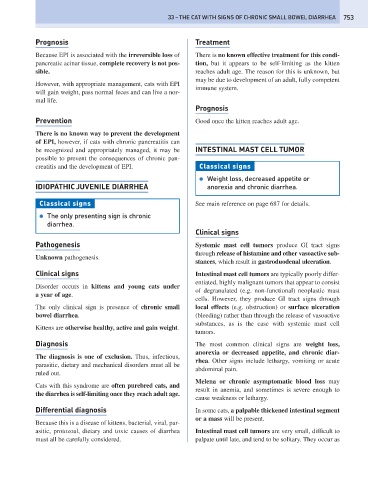Page 761 - Problem-Based Feline Medicine
P. 761
33 – THE CAT WITH SIGNS OF CHRONIC SMALL BOWEL DIARRHEA 753
Prognosis Treatment
Because EPI is associated with the irreversible loss of There is no known effective treatment for this condi-
pancreatic acinar tissue, complete recovery is not pos- tion, but it appears to be self-limiting as the kitten
sible. reaches adult age. The reason for this is unknown, but
may be due to development of an adult, fully competent
However, with appropriate management, cats with EPI
immune system.
will gain weight, pass normal feces and can live a nor-
mal life.
Prognosis
Prevention Good once the kitten reaches adult age.
There is no known way to prevent the development
of EPI, however, if cats with chronic pancreatitis can
be recognized and appropriately managed, it may be INTESTINAL MAST CELL TUMOR
possible to prevent the consequences of chronic pan-
creatitis and the development of EPI. Classical signs
● Weight loss, decreased appetite or
IDIOPATHIC JUVENILE DIARRHEA anorexia and chronic diarrhea.
Classical signs See main reference on page 687 for details.
● The only presenting sign is chronic
diarrhea.
Clinical signs
Pathogenesis Systemic mast cell tumors produce GI tract signs
through release of histamine and other vasoactive sub-
Unknown pathogenesis.
stances, which result in gastroduodenal ulceration.
Clinical signs Intestinal mast cell tumors are typically poorly differ-
entiated, highly malignant tumors that appear to consist
Disorder occurs in kittens and young cats under
of degranulated (e.g. non-functional) neoplastic mast
a year of age.
cells. However, they produce GI tract signs through
The only clinical sign is presence of chronic small local effects (e.g. obstruction) or surface ulceration
bowel diarrhea. (bleeding) rather than through the release of vasoactive
substances, as is the case with systemic mast cell
Kittens are otherwise healthy, active and gain weight.
tumors.
Diagnosis The most common clinical signs are weight loss,
anorexia or decreased appetite, and chronic diar-
The diagnosis is one of exclusion. Thus, infectious,
rhea. Other signs include lethargy, vomiting or acute
parasitic, dietary and mechanical disorders must all be
abdominal pain.
ruled out.
Melena or chronic asymptomatic blood loss may
Cats with this syndrome are often purebred cats, and
result in anemia, and sometimes is severe enough to
the diarrhea is self-limiting once they reach adult age.
cause weakness or lethargy.
Differential diagnosis In some cats, a palpable thickened intestinal segment
or a mass will be present.
Because this is a disease of kittens, bacterial, viral, par-
asitic, protozoal, dietary and toxic causes of diarrhea Intestinal mast cell tumors are very small, difficult to
must all be carefully considered. palpate until late, and tend to be solitary. They occur as

